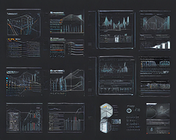Some say graphic design has existed since the prehistoric era. However, the Second Industrial Revolution in the late 1800s marked the beginning of modern graphic design. Technological development over the years has caused massive changes in graphic design. Along with technological advancements, graphic design has evolved and replaced traditional equipment like easels and canvases with digital screens and design software.
Graphic design software has gone through hoops and loops in the last decade. They provide a more efficient means of working together and sharing thoughts. Recent developments in graphic design have brought about several interesting new features, such as:
With augmented reality, people can engage with the design as though it were real. This creates an environment more conducive to exploration by blending in with nature. Because it lets us view 3D objects in real time, it makes them more realistic and immersive.
Immersed in a computer-generated environment, users can manipulate virtual objects and experiences without ever setting foot in the real world. XR makes use of virtual reality. Thanks to AR, VR, and XR, we now have sensory design. Users engage with their surroundings through wearable technology and multimodal interactions.
Two examples of AI changing businesses’ operations are improved processes and brand compliance. In 2015, just 10% of companies included AI in their routine processes. In 2019, that number reached 37%, an increase of 270% in such a brief time.
Although this might be considered a negative aspect of technology in graphic design, graphic artists should feel confident that robots won’t take their jobs in the near future. AI in graphic design is designed to supplement human designers rather than supplant them. Robots and algorithms can enhance processes and brand asset administration.
Hybrid automation is the result of combining AI and ML with automation. The ability to think creatively is still distinctly human.
 There has been a shift on the web. Web 3.0 incorporates AI and ML technology, distributes the internet, and introduces progressive web apps. New designs are also available with Web 3.0. Website 1.0’s guiding principle was “One-dimensional.” There is a strict hierarchy and sequential placement of most of the design elements. A new dimension was introduced with Web Design 2.0. With the new adaptable grids, you have even more leeway to arrange cells as you see fit.
There has been a shift on the web. Web 3.0 incorporates AI and ML technology, distributes the internet, and introduces progressive web apps. New designs are also available with Web 3.0. Website 1.0’s guiding principle was “One-dimensional.” There is a strict hierarchy and sequential placement of most of the design elements. A new dimension was introduced with Web Design 2.0. With the new adaptable grids, you have even more leeway to arrange cells as you see fit.
Web design 3.0 is the subsequent level. Because of this, pieces may be layered and overlapped with ease, opening up new possibilities for site design. The dawn of a new age in website design is upon us. The designers are now learning the ropes of the design language and the tools at their disposal. Background shapes and curves are commonly used in Web 3.0 to enforce a specific design navigation direction. In addition to creating an attractive user interface, these shapes and blobs draw attention to important material.
Computers and people have developed a type of relationship known as the human-computer interaction (HCI). The different fields of interest that take part in HCI are computer science, ergonomics, human factors, and psychology. Conversational interface is also another field to take into account, in which chatbots are major examples that have already skyrocketed. A new graphic design is also necessary for this. The field of graphic design also has to broaden its scope to include people with disabilities.
One of the most tedious tasks for a graphic designer is dealing with revisions. Many parties are typically involved in professional graphic design projects—the final product results from teamwork between individuals from different departments and sometimes even other companies.
Designers have had to endure an endless stream of feedback and revisions. Many redesigns occur because clients and designers need to communicate more effectively, particularly when interacting online.
Now, in an effort to satisfy that need, businesses and design teams have enhanced the revision process with graphic design tools. Some examples of such applications are Skitch, Figma, and Artwork Flow.
Technology will play a pivotal role in the years to come. Designers can generate user interfaces using natural language descriptions or machine learning to auto-complete designs, similar to the predictive text feature on your phone’s keyboard. Companies may also go after remote IT support for small business to ask for assistance in this field.